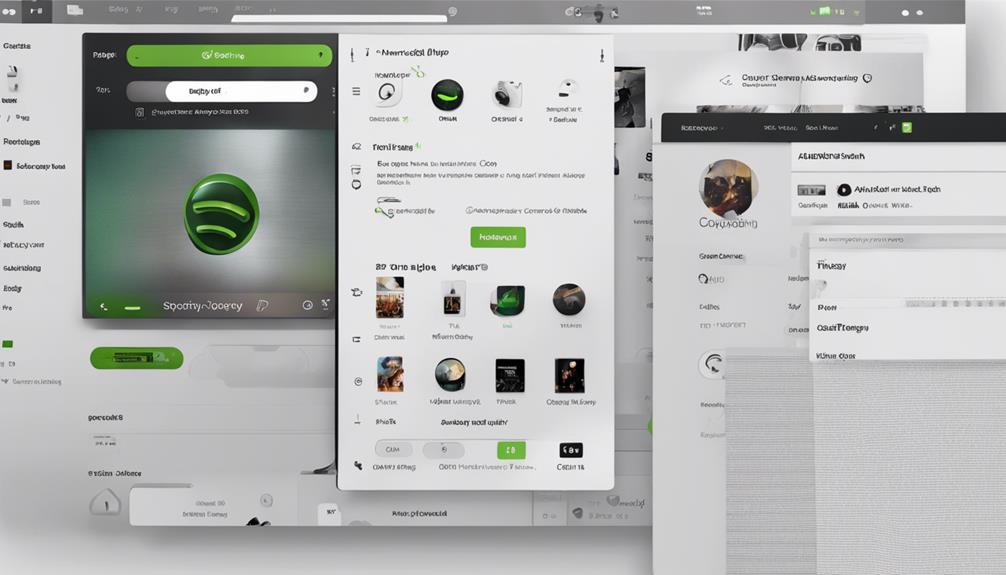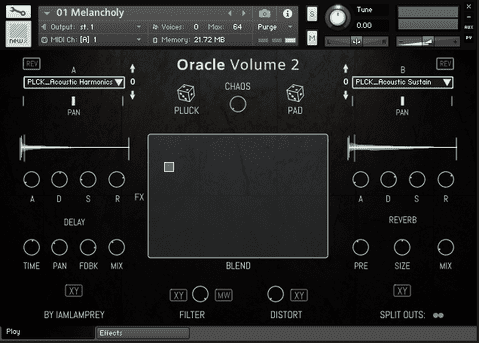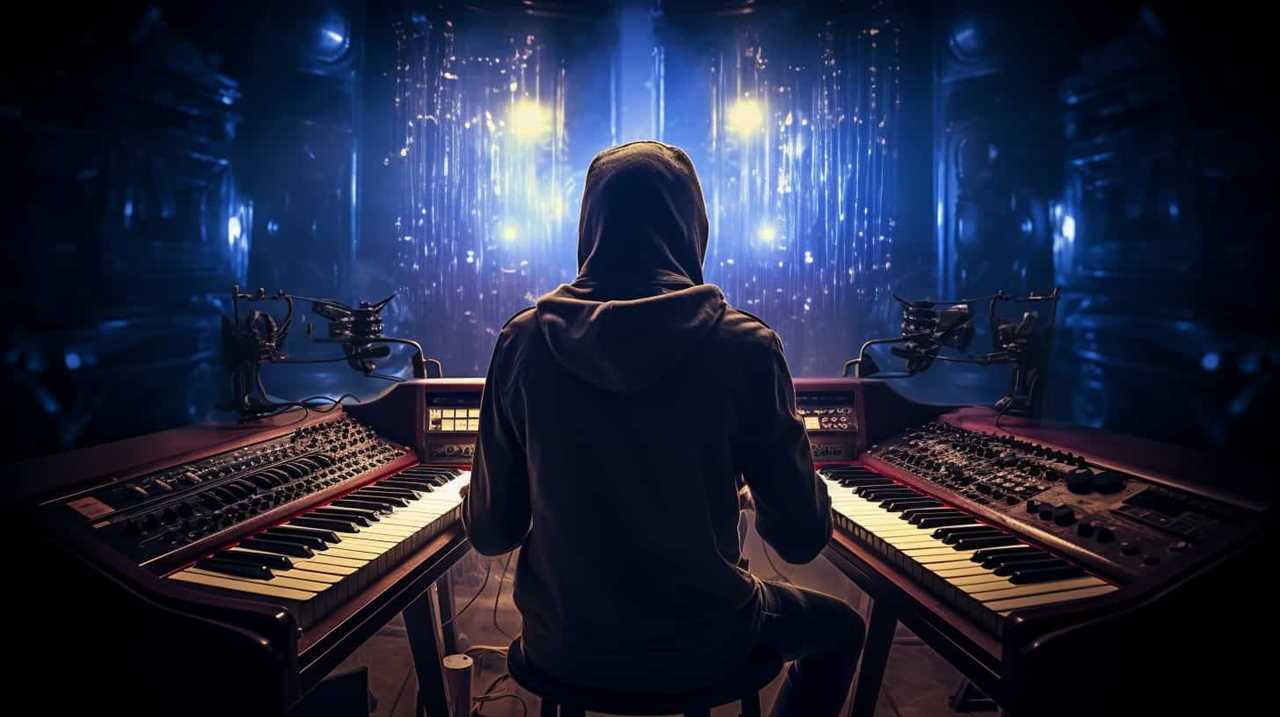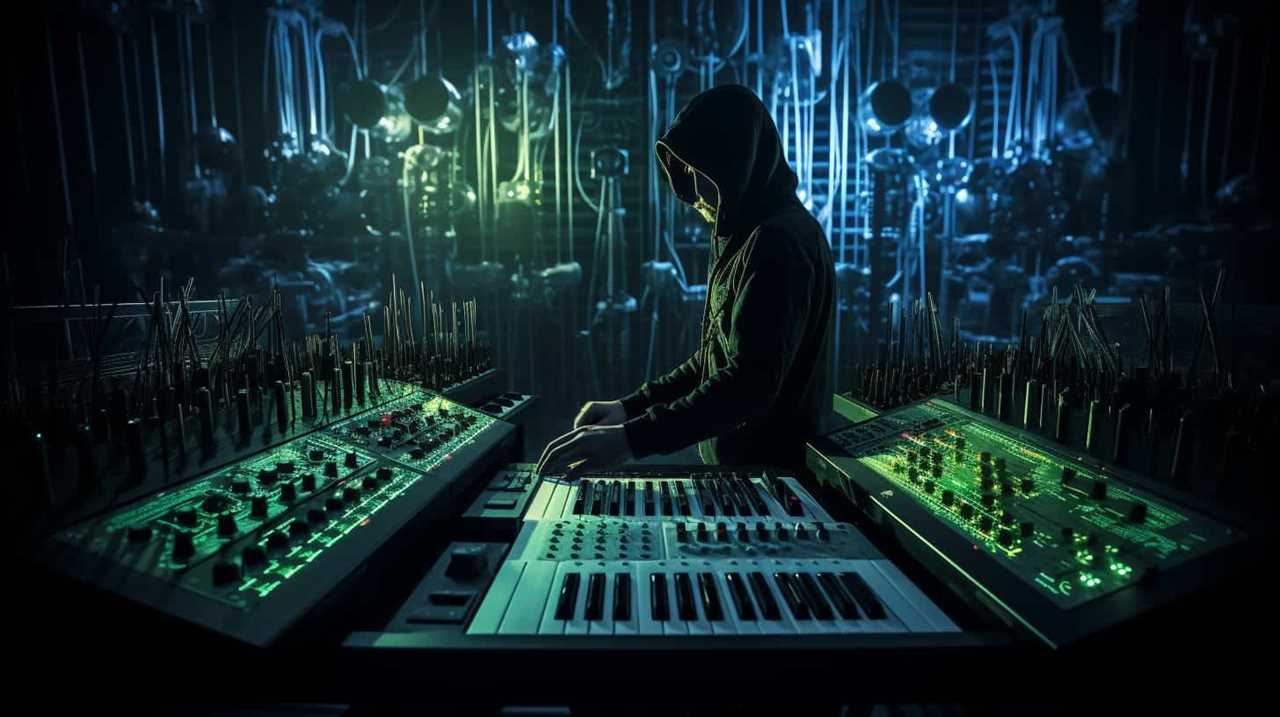We, fans of dark ambient music, invite you to embark on a unique auditory journey with us.
In the realm of soundtracking shadows, we unveil the secrets to creating haunting melodies, manipulating atmospheric textures, and crafting spine-chilling sound effects.
Through the art of field recordings, experimentation with drone and noise, and the mastery of mixing and mastering, we will guide you toward maximum impact.
Prepare to push the boundaries of innovation and immerse yourself in the captivating world of dark ambient music.

Key Takeaways
- Dark ambient music goes beyond conventional song structures and aims to create an immersive and captivating genre.
- Haunting melodies are created through eerie chord progressions, atmospheric soundscapes, dissonant intervals, and unconventional harmonies.
- Manipulating atmospheric textures involves using dissonant harmonies, overlaying various textures, manipulating timbre, and employing filters, modulation, and spectral manipulation techniques.
- Crafting spooky sound effects involves incorporating eerie soundscapes and haunting melodies, using found objects, manipulating everyday sounds, and pushing the boundaries of traditional sound design.
Understanding the Dark Ambient Genre
We need to delve into the dark ambient genre to truly understand its essence.
Dark ambient music is a genre that goes beyond conventional song structures; it’s an exploration of sonic landscapes that aim to establish a haunting mood.
The genre embraces experimentation and pushes the boundaries of traditional music composition.
Creating Haunting Melodies
When it comes to creating haunting melodies in dark ambient music, two key aspects to master are eerie chord progressions and atmospheric soundscapes.

Eerie chord progressions can be achieved by using dissonant intervals and unconventional harmonies that evoke a sense of unease and tension.
Meanwhile, atmospheric soundscapes play a crucial role in setting the mood and creating a haunting atmosphere. Elements such as drones, textures, and field recordings are used to immerse the listener in a dark and eerie sonic environment.
Eerie Chord Progressions
As we delve into the realm of creating haunting melodies, it’s essential to master the art of eerie chord progressions. These progressions, characterized by dissonant harmonies and minor scales, have the power to evoke a sense of unease and mystery.
Here are three key elements to consider when crafting eerie chord progressions:

-
Exploration of dissonance: Embrace the clash of dissonant intervals, such as minor seconds and tritones, to create tension and a chilling atmosphere.
-
Experimenting with minor scales: Utilize the melancholic and haunting qualities of minor scales, such as the natural minor and harmonic minor, to add depth and darkness to your melodies.
-
Unpredictable chord movements: Break away from traditional chord progressions and explore unconventional movements to keep the listener on edge and enhance the eerie atmosphere.
Atmospheric Soundscapes
By immersing ourselves in the creation of atmospheric soundscapes, we can craft haunting melodies that transport listeners to eerie and otherworldly realms. Exploring sonic landscapes allows us to push the boundaries of conventional music and create a sense of unease.

Through the clever use of dissonant tones, sparse instrumentation, and subtle textures, we can manipulate the listener’s emotions and draw them into a world that’s both captivating and unsettling.
It’s in these atmospheric soundscapes that true innovation in dark ambient music can be found.
Manipulating Atmospheric Textures
How can we effectively manipulate atmospheric textures to create a haunting and immersive dark ambient music experience? Here are three techniques to master:
-
Creating tension: By using dissonant harmonies, unpredictable rhythms, and unsettling sound design, we can evoke a sense of unease and anticipation in the listener. This tension adds depth and intrigue to the music, keeping the audience engaged and on the edge of their seats.

-
Layering effects: By overlaying various atmospheric textures, such as drones, field recordings, and manipulated samples, we can create a rich sonic landscape that envelops the listener. This layering adds complexity and depth to the music, allowing for a more immersive and captivating experience.
-
Manipulating timbre: By altering the tonal quality of the sounds, we can evoke different emotions and moods within the music. Experimenting with filters, modulation, and spectral manipulation techniques can transform ordinary sounds into eerie, otherworldly textures, further enhancing the dark ambient atmosphere.
Mastering the art of manipulating atmospheric textures is essential in creating a truly haunting and immersive dark ambient music experience. By employing these techniques, we can push the boundaries of conventional music production and deliver innovative and captivating compositions that transport listeners to mysterious and unsettling sonic realms.
Crafting Spooky Sound Effects
When it comes to crafting spooky sound effects, we can elevate the dark ambient music experience by using eerie soundscapes and haunting melodies. Creating atmospheric tension is essential in captivating our audience and immersing them in a chilling sonic environment.

To achieve this, we can incorporate found objects into our compositions. By manipulating and distorting everyday sounds, we can create unique and unsettling textures that add an extra layer of unease to our music.
This innovative approach allows us to push the boundaries of traditional sound design and create truly haunting and immersive sonic experiences.
Utilizing Field Recordings
We skillfully incorporate field recordings into our compositions to add an extra layer of realism and depth to our dark ambient music.
Field recordings allow us to explore environments and capture the unique sounds found within them.

This adds a sense of authenticity to our compositions, immersing the listener in a world of darkness and mystery.
Experimenting With Drone and Noise
But, as composers of dark ambient music, we also enjoy experimenting with drone and noise to create unsettling and atmospheric soundscapes. Exploring dissonance and distortion allows us to push the boundaries of traditional harmony, creating a sense of unease and tension in our compositions.
We also find that incorporating unconventional instrumentation, such as modified guitars or found objects, adds a unique texture to our music. By embracing these experimental techniques, we can further enhance the darkness and depth of our soundscapes.
Now, let’s explore how mixing and mastering can maximize the impact of our compositions.

Mixing and Mastering for Maximum Impact
By carefully balancing the levels and frequencies of our tracks, we can create a cohesive and immersive listening experience.
When it comes to mixing and mastering dark ambient music for maximum impact, there are several key techniques to consider:
-
Enhancing low frequencies: Deep, rumbling bass tones can add a sense of darkness and weight to the music. By boosting and shaping the low end, we can create a visceral and enveloping sonic experience.
-
Creating dynamic contrasts: Dark ambient music often thrives on the juxtaposition of quiet, atmospheric passages and intense, unsettling moments. By carefully controlling the volume and dynamics of different elements, we can create a sense of tension and release that keeps the listener engaged.

-
Utilizing spatial effects: Adding spatial effects such as reverb and delay can enhance the atmosphere and depth of the music. By placing sounds in different parts of the stereo field, we can create a sense of movement and immersion that adds to the overall impact.
Incorporating these techniques into the mixing and mastering process can elevate dark ambient music to new heights, ensuring that the listener is completely captivated by the haunting and atmospheric soundscape.
Frequently Asked Questions
What Are Some Common Instruments Used in Dark Ambient Music?
In dark ambient music, we often explore unique instrumentation to create unconventional sounds that contribute to the eerie and atmospheric nature of the genre.
Layering techniques are also crucial in building depth and complexity in the music, allowing for an immersive and haunting experience.

How Do You Create a Sense of Tension and Unease in Dark Ambient Music?
Creating suspense and building sonic landscapes in dark ambient music requires a careful balance of elements. We must manipulate sound textures, layering eerie melodies with dissonant harmonies.
By incorporating unconventional instruments and experimental techniques, we can create a sense of tension and unease that keeps the listener on edge. It’s important to explore the darker realms of sound, pushing boundaries and challenging traditional notions of music.
In doing so, we can truly master the art of crafting a haunting and immersive sonic experience.
Can You Provide Examples of Famous Dark Ambient Artists or Albums?
When exploring the realm of dark ambient music, it’s essential to familiarize oneself with the works of famous artists and albums that have shaped this genre. Lustmord, a renowned figure in dark ambient, has crafted haunting sonic landscapes that immerse listeners in a sense of foreboding.

Another noteworthy album is Brian Eno’s ‘Ambient 4: On Land,’ which delves into the eerie depths of atmospheric soundscapes.
These influential works showcase the historical origins and evolution of dark ambient, providing a foundation for innovative exploration within the genre.
Is It Necessary to Have a Background in Music Theory to Create Dark Ambient Music?
Creating dark ambient music doesn’t necessarily require a background in music theory. While knowledge of theory can certainly be helpful, it’s not a prerequisite for diving into the genre.
In fact, many dark ambient artists rely heavily on improvisation and experimentation, allowing the music to unfold organically.

Exploring unconventional sound sources, such as field recordings or manipulated found sounds, is also a key aspect of creating unique and atmospheric dark ambient compositions.
How Can One Incorporate Vocals Into Dark Ambient Music Without Disrupting the Atmospheric Qualities?
Incorporating vocals into dark ambient music is a delicate task that requires skill and precision. Blending voices seamlessly with the atmospheric qualities of the genre can elevate the overall experience.
One approach is to utilize ethereal chants, which can add an otherworldly dimension to the music. Careful consideration must be given to the vocal placement, ensuring that it doesn’t disrupt the immersive and introspective nature of dark ambient music.
Conclusion
In conclusion, mastering the art of creating dark ambient music requires a deep understanding of the genre, along with the ability to craft haunting melodies, manipulate atmospheric textures, and utilize field recordings effectively.

Additionally, experimenting with drone and noise elements adds an extra layer of eeriness to the composition.
Lastly, don’t underestimate the importance of mixing and mastering, as it can greatly enhance the impact of the final piece.
So, embrace the shadows, delve into the unknown, and let your dark ambient music send shivers down spines.









